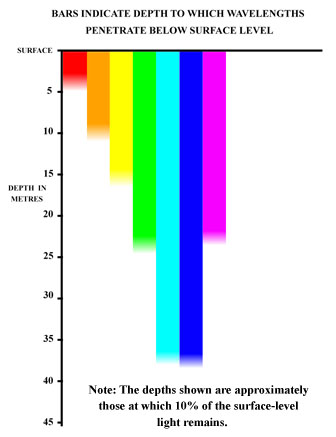 Water has a significant effect upon light. The white light in which we experience the above-water world consists of a range of electromagnetic wavelengths. When separated, these wavelengths are seen as the visible spectrum - red, orange, yellow, green, blue and (indigo) violet. Note that indigo is no longer generally regarded as a separate colour. The wavelengths, and hence colours, of these various elements of the visible spectrum are progressively absorbed by water as the depth increases.
Water has a significant effect upon light. The white light in which we experience the above-water world consists of a range of electromagnetic wavelengths. When separated, these wavelengths are seen as the visible spectrum - red, orange, yellow, green, blue and (indigo) violet. Note that indigo is no longer generally regarded as a separate colour. The wavelengths, and hence colours, of these various elements of the visible spectrum are progressively absorbed by water as the depth increases.
At the surface of the water, all the component colours are present and we perceive white light. However, as light penetrates below the surface, the wavelengths within the normal visible spectrum are progressively but unequally removed by absorption. The longer wavelengths (lower frequencies) at the red end of the spectrum are absorbed first, so an eye or camera descending below the surface will initially perceive an increasingly blue cast. This is a direct result of the absorption of the red part of the spectrum. All the other colours within the visible spectrum are also progressively absorbed, but the colours with shorter wavelengths, those at the blue end of the spectrum, penetrate the deepest. Those at the red end of the spectrum are absorbed approximately six times faster than those at the blue end.
 At a depth of only 5 metres almost all the reds are absorbed, and at about 10 metres below the surface all the reds and most of the oranges have been removed. At about 15 metres all the yellow and much of the violet ranges of wavelengths have been absorbed, and at around 25 to 35 metres below the surface the greens and blues are mostly gone. Since absorption significantly affects the whole visible spectrum at such depths, the underwater world turns grey at this point. At the so-called euphotic depth, only 1% of the light available at the surface is present. This depth varies with the clarity of the water but might typically be in the region of 200 metres in open ocean. Further down, typically below 350 metres, everything is close to black. Note that the depths quoted do not represent boundaries because absorption is a gradual process, however the figures give a general idea of the optical effects of increasing depth.
At a depth of only 5 metres almost all the reds are absorbed, and at about 10 metres below the surface all the reds and most of the oranges have been removed. At about 15 metres all the yellow and much of the violet ranges of wavelengths have been absorbed, and at around 25 to 35 metres below the surface the greens and blues are mostly gone. Since absorption significantly affects the whole visible spectrum at such depths, the underwater world turns grey at this point. At the so-called euphotic depth, only 1% of the light available at the surface is present. This depth varies with the clarity of the water but might typically be in the region of 200 metres in open ocean. Further down, typically below 350 metres, everything is close to black. Note that the depths quoted do not represent boundaries because absorption is a gradual process, however the figures give a general idea of the optical effects of increasing depth.
A very similar effect on colour takes place with increasing horizontal distance. A brightly-coloured fish at a distance of a couple of metres retains its exotic hues, but at ten metres the reds, oranges and yellows are all attenuated and the creature looks much less colourful. Remember that the two distances, depth under the water and horizontal distance from the subject, are additive. When a diver is 8 metres underwater and photographing a subject 5 metres away, the light recorded by the camera has travelled 13 metres through water and almost all the reds, oranges and yellows will have been absorbed. The best way to restore the natural bright colours is to illuminate the subject with a full-spectrum underwater lamp.






